The thing I want to savor more than anything else is the ‘source’ from which the work originates. All I really want to do is to touch it, to get truly close to it.
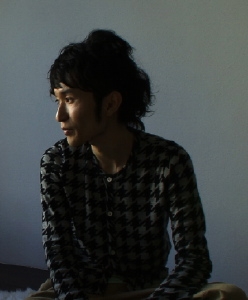
Beautiful, fleeting images based on scenes encountered around the world woven together using what could be described as Takagi’s ‘trademark’ image processing and music. Several years ago this might have served as a description of Takagi’s work, but the project that began last year with a concert in which the artist appeared with a band underscored the extent to which things have changed, albeit quietly. We met the artist in the midst of this project, which has grown to include the release of a CD and documentary film.
Interviewer: ART iT
– The Tai Rei Tei Rio project roughly coincides with the tenth anniversary of the launch of your career as an artist. It really doesn’t seem that long ago, but how does it feel now looking back on those early days?
One thing I can say is that my timing was good. What I mean by that is I started expressing my ideas using video and music at around the time video installations were starting to come to the fore in the art world and when ‘sound’ was starting to really take off in the music world. I didn’t come from a so-called art background; I haven’t been through art school or music school. But somehow I managed to work my way in, and opportunities then opened up in other fields such as fashion and advertising. As I said, a lot of it had to do with the changes that were going on around me.
– What about the future, then? Is that something you think about at a time like this?
It’s only in the last one or two years that I’ve finally started to think seriously about what it is I really want to do. When you’ve been doing the same thing for ten years, everything starts to get sorted out and assimilated, but at the same time you inevitably start to get sick of some aspects of your work. As I just said, in a sense I was lucky, but I also sensed that I wasn’t really at home in either field. I never really felt that any of my work was great in the true sense of the word. Which led to Tai Rei Tei Rio, which came about because I felt strongly that I wanted to do an installation in a hall rather than in an art museum. Something that was at the same time a concert, an exhibition, and a piece of theater. So that’s the kind of thing I wanted to create. I also had this idea that in terms of the environment, too, a hall was probably the only place where I could get the visuals and audio to come together the way I wanted.
The Tai Rei Tei Rio project
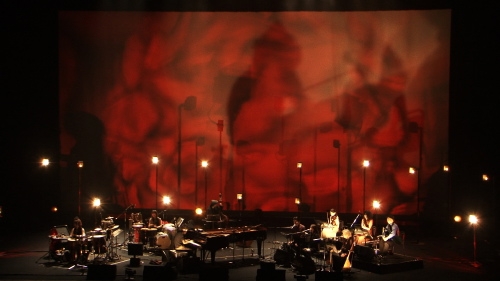 Still from the film Aruongaku showing a scene from a Tai Rei Tei Rio concert
Still from the film Aruongaku showing a scene from a Tai Rei Tei Rio concert
– With regard to the birth of this project, I understand that some people in other fields whom you met in the course of your existing activities played an important role.
I’m particularly indebted to Nakazawa Shinichi (religious scholar and cultural anthropologist), whom I met when I was invited to Tama Art University, and to the folk at the Riken Institute, whom I met after being commissioned to create a work that conveyed the image of cell research. Although they carry out research in different fields, in both cases the scale of their work is huge in that they’re looking for answers to fundamental questions. You could also say that coming into contact with these kinds of fields gave me an idea for something I wanted to try even if the risk of failure was high.
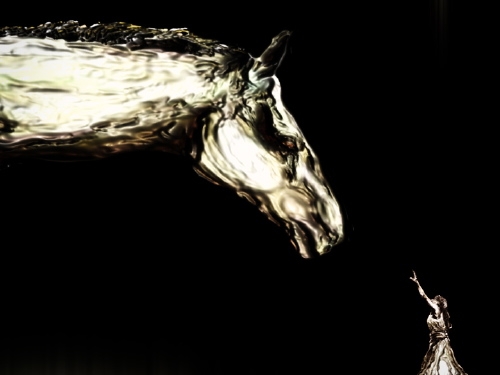 Homicevalo 2008
Homicevalo 2008Created in collaboration with the Institute for Art Anthropology (Nakazawa Shinichi, director), Tama Art University
– I think it’s fair to say that in your previous work there was a very clear sense of being taken on a ‘journey’ through the world or through life with the aid of stylish images. But with the Tai Rei Tei Rio concerts in Tokyo and Iwate, the atmosphere was more one of encompassing the world. At the same time, there was almost an oriental whiff in the air… I heard that this stemmed in part from the worldview that seeks from a linguistic perspective to find the roots of Japan in and around Polynesia (Editor’s note: ‘tai rei tei rio’ is Polynesian for ‘swing high, swing low’). What are your own thoughts on this?
Well…firstly, I’m strongly attracted to the Japanese culture of old. I really enjoy looking at old pots and bowls, and I think up until the Edo period Japanese culture had a lot going for it. On the other hand, there’s something about present-day Japan – and I include myself in this – that I find dissatisfying. I often think, Isn’t it time we went back to what we had before and continued on from there? I’ve traveled around various countries, and looking back on it now, in a sense I was walking around looking for a place that resembled the Japan of old.
Some people might say, Well, why the piano then? (Editor’s note: during performances of Tai Rei Tei Rio, Takagi plays the piano and sings) to which I’d respond that as long as you can produce sound with the kind of feeling people have sought for the last few hundred years then any instrument will do. The past is the past, and it’s not as if we’re trying to copy the past. If you can pass on not what’s visible but what’s invisible, then you can perform new music using new instruments. If you keep that in mind when you’re playing then the tone color changes completely.
The extent to which you can touch the ‘other party’
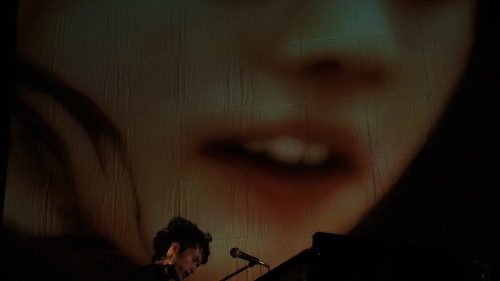 Still from the film Aruongaku showing a scene from a Tai Rei Tei Rio concert
Still from the film Aruongaku showing a scene from a Tai Rei Tei Rio concert
– Later, you included with the CD based on the music from this concert a collection of myths inspired by the music. When you get down to it, is there some kind of essential idea that you’re drawn to again and again?
When I started creating this work, I knew what it was I wanted to achieve but I didn’t know how to go about it. As I tried messing with various things, the range of expression broadened. However, rather than, for example, melody and structure in the case of music, what I really wanted to capture was a “sense.” Recently I’ve gone back and re-archived my favorite music, and what I’ve found is that I really enjoy old lullabies – songs that are actually sung to children. These songs are not sung as art. All the singer is doing is conversing with the person in front of them via music.
My family home was a Buddhist temple, so I grew up listening to chanting as though it were music, and these days I sometimes listen to my own melodies and think, So, that’s where it all came from! Also, at one stage, whenever I met a curator from a museum I’d hit them with the simple question, What is art? and the answer would always be different, although maybe that’s to be expected. So maybe it was inevitable that my thoughts would turn to wall paintings in caves and questions relating to when humans first started to draw pictures. Such as what they draw, and how and why they drew those things. It was the same with the genre of sound. Once I was able to work out the answers in my own way, the work that resulted changed.
– Certainly, the impression I got from watching the concert as well as Aruongaku, the documentary film based on it, was different from that of your other work. What did the performance mean for you personally?
Actually, I’m sorry to say that I went into it thinking, I’m just going to ignore the audience (laughs). In actual fact, it wasn’t until the very end of the final performance in Meguro that I became aware of the presence of the audience. But even looking at it from the audience’s perspective, that’s the kind of thing they want to see, isn’t it. It’s not what you actually create that’s the most important thing. The important thing (for both the performer and the audience) is the extent to which you can touch the ‘other party’. The moment the work comes into being is incredibly intense. Of course the resultant work itself is interesting, but the thing I want to savor more than anything else is the ‘source’ from which the work originates. All I really want to do is to touch it, to get truly close to it.
Takagi Masakatsu
Born 1979 in Kyoto. His creative output involving film and music finds outlets ranging from exhibitions to concerts and includes video performances for David Sylvian’s European concert tour, music videos for ‘UA’ and YUKI’, and collaborations with academic organizations such as the Center for Developmental Biology and Institute for Art Anthropology. His new CD Tai Rei Tei Rio (released as a package with a collection of myths linked to the sounds) is based on a concert staged in June from his project of the same title launched with a concert in 2008. And a documentary film focusing on Takagi and began screening this week (details below).
Aruongaku*, Tomihisa Takashi’s documentary film about Takagi (produced/distributed by Epiphany Works), is screening together with Takagi’s films Homiĉevalo and NIHITI at Shibuya Eurospace (4 – 24 July), Nagoya Cinematheque (18- 25 July) and thereafter at other theatres throughout Japan.
*Aruongaku has been selected to screen at the SHINSEDAI Cinema Festival (21-23 August), a film festival devoted to Japanese film launching this year in Toronto.
Aruongaku trailer
Tai Rei Tei Rio CD + Book of related myths
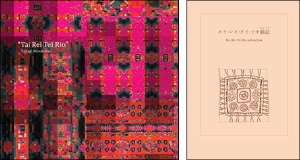
Released from Epiphany Works
Distributed by Blues Interactions
EPCT-1
3,000 JPY
http://www.epiphanyworks.net/trtr
